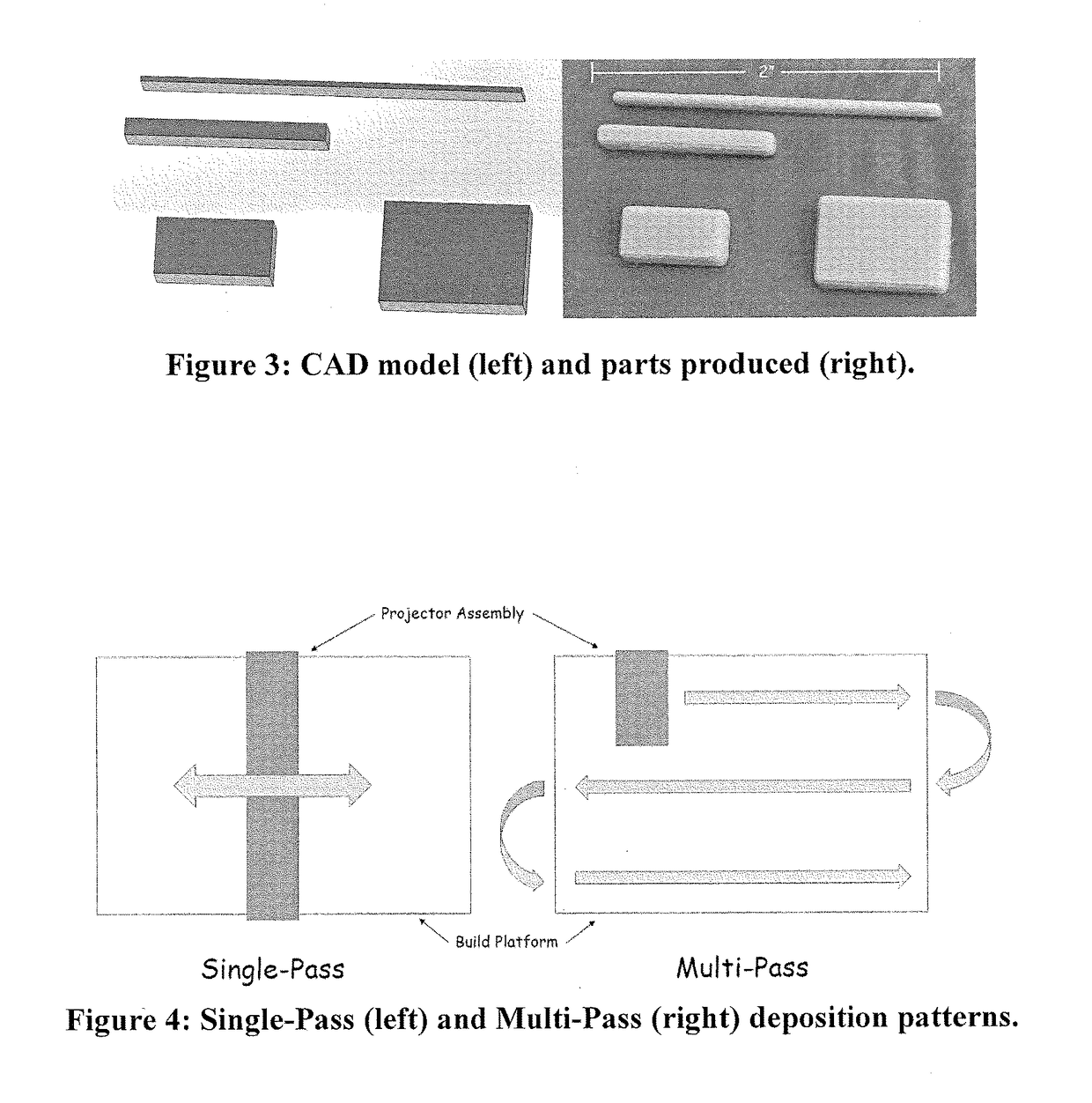Method and apparatus for three-dimensional fabrication
a three-dimensional object and fabrication method technology, applied in the direction of additive manufacturing, manufacturing tools, additive manufacturing, etc., can solve the problems of difficult production of large objects such as automotive parts by additive manufacturing techniques, high cost of resins, and relatively short “pot li
- Summary
- Abstract
- Description
- Claims
- Application Information
AI Technical Summary
Benefits of technology
Problems solved by technology
Method used
Image
Examples
example 1
Example Apparatus
[0132]A first embodiment of an apparatus (FIG. 2) of the invention was built around a “Rep-Rap” frame 16, which provides single-axis motion of the build platform 15, and up-down motion for the light source 11, belt 13, and a roller assembly 12 on which a belt is mounted. The belt was created from a TEFLON® fluorinated ethylene propylene film, CS Hyde Item No. 23-3FEP-24 (CS Hyde Co., 1351 N. Milwaukee Ave., Lake Villa, Ill. 60046 USA). The roller assembly included a set of stepper motors and rollers which cause the belt to roll along the assembly. A WINTECH PRO4500 ultraviolet digital light projector (available from Wintech Digital Systems Technology Corp., 2888 Loker Ave. East, STE210C, Carlsbad, Calif. 92010 USA), was mounted onto the assembly, projecting an image onto the belt window formed by the orientation of the belt and the roller assembly. In this embodiment, resin is applied to the part manually before rolling the film over the part and exposing each layer...
example 2
Fabrication of Three-Dimensional Objects
[0133]A UV-curable resin comprised of 76 parts Sartomer CN2920, 5 parts isobornyl acrylate, 19 parts cyclohexanedimethanol divinyl ether, 0.5 parts Irgacure 819 photoinitiator, 0.04 parts Wikoff SCUV 14607 Black, and 0.16 parts Wikoff SCUV 14611 White was provided.
[0134]A test fabrication was performed using the resin was carried out with the apparatus of Example 1, with a slice height of 100 microns and manual application of the resin to the film on each pass. Results are shown in FIG. 3. Not including manual resin application (which will be automated in future revisions and add minimal time), each layer took approximately 1.5 seconds (0.5 second exposure, 1 second move). With a slice height of 100 microns, this correlates to a fabrication speed of approximately 240 millimeters per hour.
example 3
Mounting of Head Assembly to CNC Machine as Second Drive Assembly
[0135]A “head assembly” apparatus comprising a source of actinic radiation, belt to which polymerizable liquid is applied, applicator for applying the polymerizable liquid to the belt, and associated interconnecting frame, as described above, is mounted or retrofitted to a commercial vertical or horizontal CNC machine (which then serves as the second drive assembly) to provide high accuracy, long distance, travel in various axes over a working bed or carrier for the object. Examples of suitable CNC machines include, but are not limited to, the HAAS VF-2, VF-4, and VF-12 / 40 vertical CNC machines, and the HAAS EC-400 and EC-400 horizontal CNC machines, available from Haas Automation, Inc., 2800 Sturgis Rd., Oxnard, Calif., 93030 USA.
PUM
| Property | Measurement | Unit |
|---|---|---|
| viscosity | aaaaa | aaaaa |
| viscosity | aaaaa | aaaaa |
| viscosity | aaaaa | aaaaa |
Abstract
Description
Claims
Application Information
 Login to View More
Login to View More - R&D
- Intellectual Property
- Life Sciences
- Materials
- Tech Scout
- Unparalleled Data Quality
- Higher Quality Content
- 60% Fewer Hallucinations
Browse by: Latest US Patents, China's latest patents, Technical Efficacy Thesaurus, Application Domain, Technology Topic, Popular Technical Reports.
© 2025 PatSnap. All rights reserved.Legal|Privacy policy|Modern Slavery Act Transparency Statement|Sitemap|About US| Contact US: help@patsnap.com



